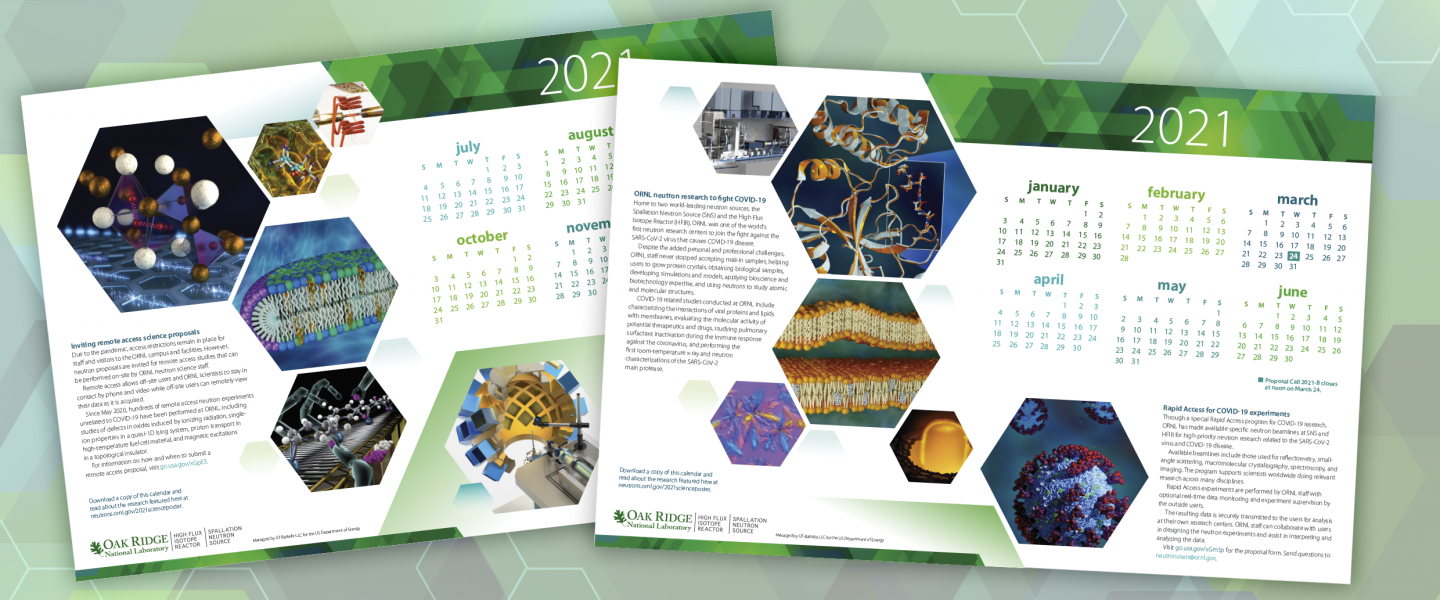SNS and HFIR 2021 Calendar Poster
December 3, 2020
The 2021 Neutron Sciences calendar poster highlights important research achievements and initiatives developed in response to COVID-19. Despite challenges imposed by the pandemic, NScD staff remained diligent in delivering cutting-edge science and staying on track with construction projects critical to new neutron scattering instruments, the Proton Power Upgrade (PPU), and the Second Target Station (STS).
For more information on some of the images featured, visit these links:
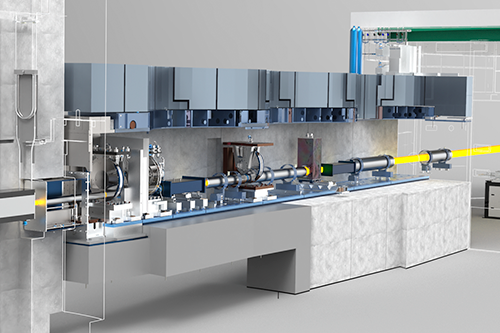 VENUS construction on track for ORNL’s newest neutron imaging instrument
VENUS construction on track for ORNL’s newest neutron imaging instrument
The VENUS beamline at ORNL’s Spallation Neutron Source (SNS) will provide the United States with an exclusive state-of-the-art imaging capability to study materials, revealing novel insights into materials used in energy storage, additive manufacturing, nuclear fuels, biological systems, and geosciences, in addition to nondestructive analysis of historical artifacts.
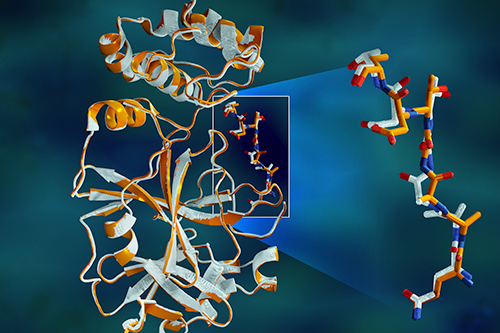 X-rays size up protein structure at the ‘heart’ of COVID-19 virus
X-rays size up protein structure at the ‘heart’ of COVID-19 virus
A team of researchers at the Department of Energy’s Oak Ridge and Argonne national laboratories has performed the first room-temperature X-ray measurements on the SARS-CoV-2 main protease—the enzyme that enables the virus to reproduce.
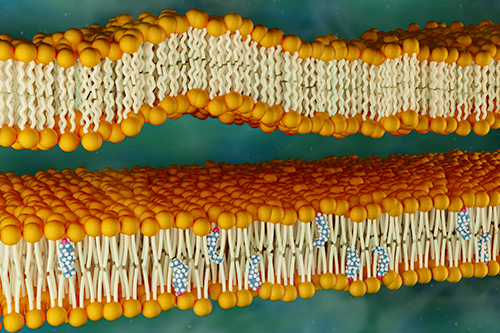 Neutrons reveal behavior of cholesterol in membranes
Neutrons reveal behavior of cholesterol in membranes
A team led by Virginia Tech physicist and former ORNL Shull Fellow Rana Ashkar used the Neutron Spin Echo Spectrometer at ORNL’s SNS to analyze the effect of cholesterol on model unsaturated lipid membranes. Using bilayer membranes with varying amounts of cholesterol, they concluded that cholesterol increases the thickness and stiffness of the membrane.
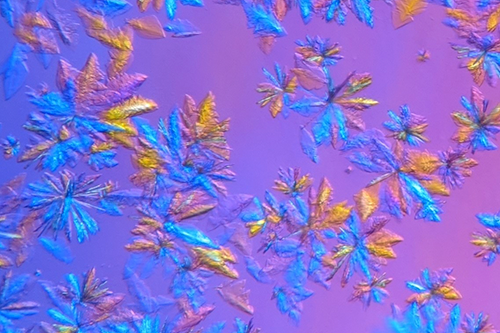 History of insightful HIV research inspires neutron scattering approach to studying COVID-19
History of insightful HIV research inspires neutron scattering approach to studying COVID-19
In January 2020, ORNL researchers were preparing to use neutrons to study the relationship between a certain HIV protease and a class of anti-retroviral drugs known as HIV protease inhibitors. When they team began, little did they know that, coincidentally, their efforts to study HIV would quickly put them on a new path to tackling COVID-19, the pandemic that now has the world in its grip.
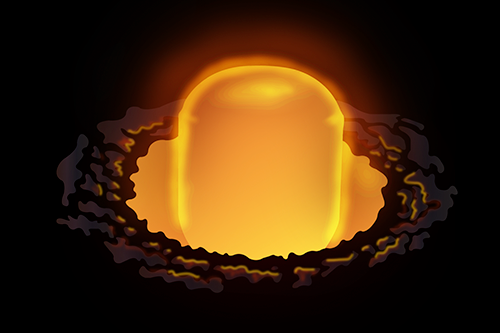 ORNL-produced plutonium-238 to help power Perseverance on Mars
ORNL-produced plutonium-238 to help power Perseverance on Mars
Pu-238 is ideal for deep-space travel because of its long half-life of nearly 88 years, but it has been in short supply. The High Flux Isotope Reactor (HFIR) was used to irradiate pellets of neptunium-237, causing the neptunium to transmute into Pu-238, which is being used to power NASA’s Perseverance rover.
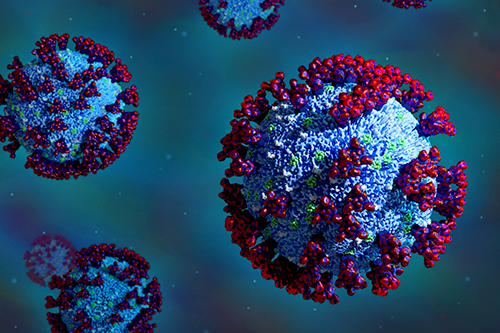 ORNL offers rapid access to neutron sources for COVID-19 research
ORNL offers rapid access to neutron sources for COVID-19 research
DOE is providing remote, rapid access to its advanced neutron source facilities at ORNL to support research related to the COVID-19 pandemic. As part of the search for effective diagnostics and therapies, rapid access will be awarded for experiments that address exceptional and essential science and technical questions identified by the COVID-19 research community.
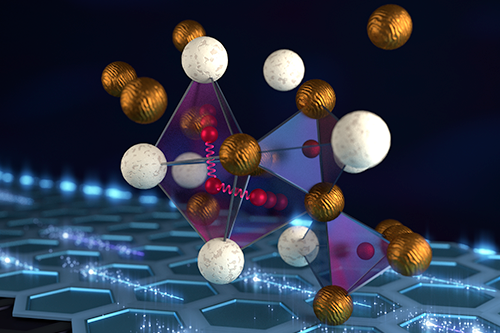 Closely spaced hydrogen atoms could facilitate superconductivity in ambient conditions
Closely spaced hydrogen atoms could facilitate superconductivity in ambient conditions
An international team of researchers has discovered the hydrogen atoms in a metal hydride material are much more tightly spaced than had been predicted for decades—a feature that could possibly facilitate superconductivity at or near room temperature and pressure
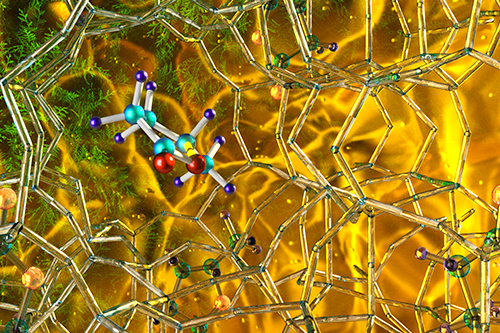 Neutrons optimize high efficiency catalyst for greener approach to biofuel synthesis
Neutrons optimize high efficiency catalyst for greener approach to biofuel synthesis
Researchers have designed a catalyst that converts biomass into fuel sources with remarkably high efficiency and offers new possibilities for manufacturing advanced renewable materials. Neutrons played a key role in determining the chemical and behavioral dynamics of a zeolite catalyst to provide information for maximizing its performance.
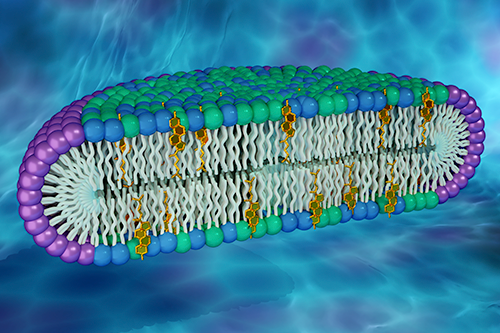 Novel cell membrane model could be key to uncovering new protein properties
Novel cell membrane model could be key to uncovering new protein properties
Researchers used neutron and X-ray scattering techniques at Oak Ridge and Brookhaven laboratories to characterize disc-shaped structures, known as bicelles, that mimic cell membranes. Studying membrane protein structures and how they behave will help scientists better understand their connection to diseases and aid in developing therapeutics.
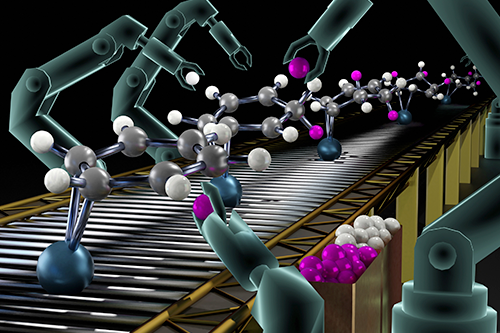 Neutrons – Deuterium shuffle
Neutrons – Deuterium shuffle
Scientists have found a new method to strategically add deuterium to benzene, an aromatic compound commonly found in crude oil. When applied to the active ingredient of drugs to incorporate deuterium, it could dramatically improve the drugs’ efficacy and safety and even introduce new medicines.
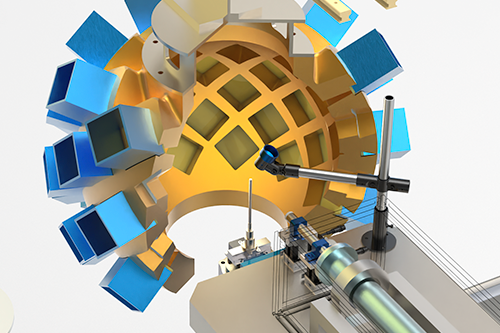 EWALD is one of the first instrument design concepts proposed to be built at the STS. The single crystal diffractometer will be optimized to collect data from crystals that are orders of magnitude smaller than those that can currently be studied. Coupled with the broad wavelength range available in a single STS pulse and the high detector coverage, EWALD will enable the rapid collection of complete data sets, and with fewer crystal orientations.
EWALD is one of the first instrument design concepts proposed to be built at the STS. The single crystal diffractometer will be optimized to collect data from crystals that are orders of magnitude smaller than those that can currently be studied. Coupled with the broad wavelength range available in a single STS pulse and the high detector coverage, EWALD will enable the rapid collection of complete data sets, and with fewer crystal orientations.
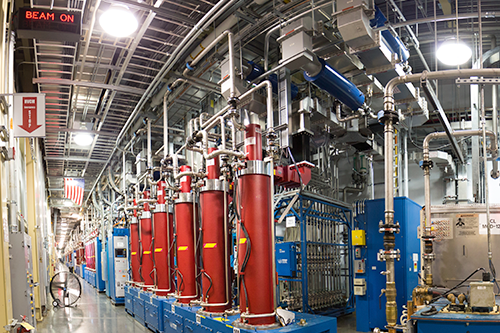 The klystron gallery at the SNS houses the radio-frequency systems that power the linear accelerator. The PPU construction project will add more radio-frequency equipment and mechanical systems inside the klystron gallery to double the power of the accelerator beam from 1.4 to 2.8 megawatts, enough power to operate the STS.
The klystron gallery at the SNS houses the radio-frequency systems that power the linear accelerator. The PPU construction project will add more radio-frequency equipment and mechanical systems inside the klystron gallery to double the power of the accelerator beam from 1.4 to 2.8 megawatts, enough power to operate the STS.
SNS and HFIR are DOE Office of Science User Facilities. ORNL is managed by UT-Battelle for the U.S. Department of Energy's Office of Science, the single largest supporter of basic research in the physical sciences in the United States. DOE’s Office of Science is working to address some of the most pressing challenges of our time. For more information, please visit https://www.energy.gov/science.


